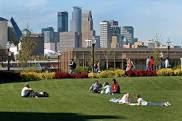University of Minnesota
The University of Minnesota Twin Cities (Minnesota, U of M) is a public research university located in Minneapolis and St. Paul, Minnesota. The Minneapolis and St. Paul campuses are approximately 5 miles (8.0 km) apart, and the Saint Paul campus is actually in neighboring Falcon Heights.[5] It is the oldest and largest campus within the University of Minnesota system and has the sixth-largest main campus student body in the United States, with 51,853 students in 2012–2013. The university is organized into 19 colleges and schools, and it has sister campuses in Crookston, Duluth, Morris, and Rochester.Minnesota's athletic teams are known collectively as the Minnesota Golden Gophers and compete in the NCAA's Division I as members of the Big Ten Conference.The original Minneapolis campus overlooked the Saint Anthony Falls on the Mississippi River, but it was later moved about a mile (1.6 km) downstream to its current location. The original site is now marked by a small park known as Chute Square at the intersection of University and Central avenues. The school shut down following a financial crisis during the American Civil War, but reopened in 1867 with considerable financial help from John S. Pillsbury. It was upgraded from a preparatory school to a college in 1869. Today, the University's Minneapolis campus is divided by the Mississippi into an East and West Bank.
The campus now has buildings on both river banks. The "East Bank", the main portion of the campus, covers 307 acres (124 ha). The West Bank is home to the University of Minnesota Law School, the Humphrey School of Public Affairs, the Carlson School of Management, various social science buildings, and the performing arts center. St. Paul campus is home to the College of Biological Sciences (CBS), the College of Design (CDes), the College of Food, Agriculture and Natural Resource Sciences (CFANS), and the veterinary program.To help simplify the size of the campus, the University has broken down the East Bank into several areas: the Knoll area, the Mall area, the Health area, the Athletic area, and the Gateway area.
The Knoll area, the oldest part of the University's current location, is located in the northwestern part of the campus.[6] Most disciplines in this area relate to the humanities. Burton Hall is home to the College of Education and Human Development. Many buildings in this area are well over one hundred years old and it includes a 13-building group comprising the Old Campus Historic District that is on the U.S. National Register of Historic Places.[7] A residence hall, Sanford Hall, and a student-apartment complex, Roy Wilkins Hall, are located in this area. The Institute for Advanced Study[8] is located in the Nolte Center. This area is located just south of the Dinkytown neighborhood and business area.
Northrop Mall, or the Mall area, is arguably the center of the Minneapolis Campus. It was based on a design by Cass Gilbert, although his plans were too extravagant to be fully implemented.[9] Several of the campus's primary buildings surround the Mall area. The Cyrus Northrop Memorial Auditorium provides a northern anchor, with Coffman Memorial Union (CMU) to the south. Four of the larger buildings to the sides of it are the primary mathematics, physics, and chemistry buildings, (Vincent Hall, Tate Laboratory and Smith Hall, respectively) and Walter Library. The Mall area is home to both the College of Liberal Arts, which is Minnesota's largest public or private college, and the College of Science and Engineering. Behind CMU is another residence hall, Comstock Hall, and another student-apartment complex, Yudof Hall.
The Health area is to the southeast of the Mall area and focuses on undergraduate buildings for biological-science students, as well as homes to the College of Pharmacy, the School of Nursing, the School of Dentistry, the Medical School, the School of Public Health, and Fairview Hospitals and Clinics. This complex of buildings forms what is known as the University of Minnesota Medical Center. Part of the College of Biological Sciences is housed in this area.
Across the street from Fairview Hospital is an area known as the "Superblock". The Superblock is a four-city-block space housing four residence halls (Pioneer, Frontier, Centennial and Territorial Halls). The Superblock is one of the most popular locations for on-campus housing because it has the largest concentration of students living on campus and has a multitude of social activities between the residence halls.
The Athletic area is directly north of the Superblock and includes four recreation/athletic facilities: the University Recreation Center, Cooke Hall, the University Fieldhouse, and the University Aquatic Center. These facilities are all connected by tunnels and skyways allowing students to use one locker-room facility. North of this complex is the TCF Bank Stadium, Williams Arena, Mariucci Arena, Ridder Arena, and the Baseline Tennis Center.
The Gateway area, an easternmost section, is primarily office buildings instead of classrooms and lecture halls. The most prominent building is McNamara Alumni Center. The University is also heavily invested in a biomedical-research initiative and is striving to build five more biomedical-research buildings in ten years that will form a biomedical complex directly north of TCF Bank Stadium.
